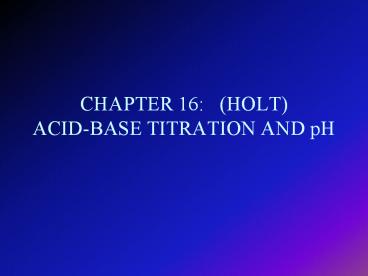CHAPTER 16: (HOLT) ACID-BASE TITRATION AND pH - PowerPoint PPT Presentation
Title:
CHAPTER 16: (HOLT) ACID-BASE TITRATION AND pH
Description:
CHAPTER 16: (HOLT) ACID-BASE TITRATION AND pH I. Concentration Units for Acids and Bases A. Chemical Equivalents 1. Definition: quantities of solutes that have ... – PowerPoint PPT presentation
Number of Views:453
Avg rating:3.0/5.0
Title: CHAPTER 16: (HOLT) ACID-BASE TITRATION AND pH
1
CHAPTER 16 (HOLT)ACID-BASE TITRATION AND pH
2
I. Concentration Units for Acids and Bases
- A. Chemical Equivalents
- 1. Definition quantities of solutes that
have equivalent combining capacity - a. Acid mass of one equivalent is
numerically equal to the mass of one mole of the
acid divided by the number of protons(H or H3O
) that one mole of the acid can provide - Example
- HCl 36 g/mol 1 eq 1H 36
g/mol H - H2SO4 98g/mol 2 eq 2H 49
g/mol H
3
- B. Base mass of one equivalent is numerically
equal to the mass of one mole of the base divided
by the number of protons(OH-) that one mole of
the base can provide - Example
- NaOH 40 g/mol 1 eq 1 OH- 40 g/mol
OH- - Ca(OH)2 74 g/mol 2 eq 2 OH- 37 g/mol
OH-
4
B. Normality
- Definition number of equivalents of solute per
liter of solution - N eq of solute
- L of solution
5
C. Relationship Between Normality and Molarity
- N nM
- N Normality
- n number of equivalents ( of H or OH-)
- M Molarity
- Example
- 1M HCl 1N HCl 1M NaOH 1N
NaOH - 1M H2SO4 2N H2SO4 1M Ca(OH)2 2N
Ca(OH)2
6
II. Aqueous Solutions and the Concept of pH
- A. Self-Ionization of Water
- 1. Definition Two water molecules interact
to produce a hydronium ion and a hydroxide ion by
proton transfer - forms a weak electrolyte - 2. is symbol used to indicate
concentration in moles per liter (Molarity) - 3. H2O H2O lt---gt H3O OH-
- in pure water H3O OH-
- 4. H3O OH- 10-14
- 5. If the H3O increases then the OH-
decreases or - If the H3O decreases then the OH-
increases
7
B. The pH scale
- 1. pH -- the negative of the common logarithm of
the hydronium ion concentration - pH -logH3O
- 2. Acid pH lt 7
- 3. Base pH gt 7
- 4. Neutral pH 7
8
C. Calculations involving pH
- pH -logH3O
- 0.001 M HCl H3O 1 x 10 -3
- pH -log1 x 10-3
- pH 3 (acid)
- Remember that H3O OH- 1 x 10-14 so
if H3O 1 x 10-3 then OH- 1 x 10-11 - FYI there is also pOH - logOH- and
- pH pOH 14
9
III. Acid-Base Titrations
- A. Indicators
- 1. Definitions
- a. indicators - weak acid or base dyes
whose colors are sensitive to pH, or hydronium,
concentration - b. transition interval - the pH range
over which an indicator changes color
10
- 2. Types of indicators
- a. Change color at about pH 7
- b. Change color below pH 7
- c. Change color above pH 7
11
B. The Principle of Titration
- Definitions
- 1. Titration - the controlled addition and
measurement of the amount of a solution of known
concentration that is required to react
completely with a measured amount of a solution
of unknown concentration - 2.Standard solution - a solution that
contains a precisely known concentration of a
solute
12
- 3. Equivalence point - in a neutralization
reaction, the point at which there are equivalent
quantities of hydronium and hydroxide ions - 4. End point - the point in a titration where an
indicator changes color - 5. Primary standard - a highly purified compound,
when used in solution to check the concentration
of the known solution in a titration
13
C. Molarity and Titration
- 1. Determine the moles of acid (or base) from the
standard solution used during titration - 2. From a balanced chemical equation, determine
the ratio of moles of acid (base) to base (acid) - 3. Determine the moles of solute of the unknown
solution used during the titration - 4. Determine the molarity of the unknown solution
14
D. Normality and Titrations
- Va x Na Vb x Nb
- Va volume of the acid
- Na normality of the acid
- Vb volume of the base
- Nb normality of the base































